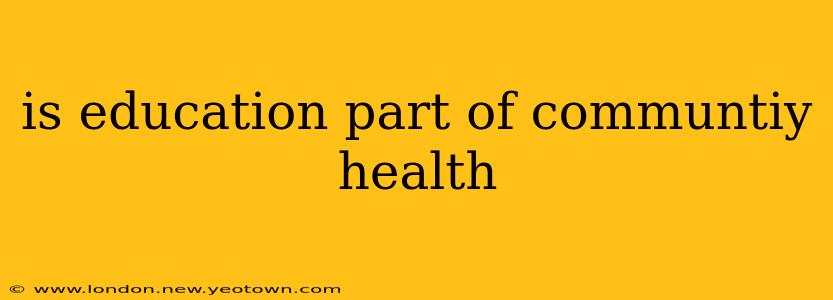Is Education Part of Community Health? A Story of Intertwined Destinies
The bustling marketplace hummed with activity. Anya, a community health worker, navigated the crowded stalls, her eyes scanning the faces around her. She wasn't just looking for signs of illness; she was observing, listening, learning. She saw malnutrition in a child's gaunt frame, understood the fear in a mother's eyes about accessing clean water, and sensed the frustration in a young man’s inability to find work. Anya knew that true community health wasn't just about treating diseases; it was about addressing the root causes of poor well-being. And at the heart of it all, she realized, lay education.
This isn't just a hunch; it's a fundamental principle. Education is deeply intertwined with community health, acting as both a preventative measure and a vital tool for empowerment. Let's explore this vital connection.
What are the key components of community health?
Community health encompasses a broad spectrum of factors impacting the well-being of a population. It's not simply the absence of disease, but the presence of factors that promote overall health and well-being within a community. This includes access to healthcare, clean water and sanitation, nutritious food, safe housing, and a supportive social environment. But something incredibly crucial often gets overlooked: education.
How does education impact community health outcomes?
Education acts as a powerful catalyst for positive health outcomes in several ways:
-
Improved Health Literacy: Education empowers individuals to understand health information, make informed decisions, and actively participate in their own care. This reduces reliance on misinformation and enhances the effectiveness of healthcare interventions. Anya, for example, knew that simply providing medicine wouldn't solve the problem of malnutrition; she needed to educate the mother on proper nutrition and hygiene practices.
-
Enhanced Economic Opportunities: Education opens doors to better job prospects, leading to increased income and improved living conditions. This translates directly into access to better healthcare, nutritious food, and safe housing – all crucial elements of community health. The young man Anya had observed was unable to secure employment because he lacked the basic literacy skills needed for many available jobs.
-
Improved Sanitation and Hygiene Practices: Education plays a significant role in promoting hygiene practices that prevent the spread of infectious diseases. Anya frequently conducted workshops on proper handwashing and sanitation, directly impacting the health of the community.
-
Empowered Decision-Making: Education equips individuals with the knowledge and skills to make informed decisions about their health and the health of their families. This includes decisions about family planning, vaccinations, and preventative healthcare.
What role does health education play in preventing disease?
Health education is a cornerstone of preventative healthcare. By providing information about healthy lifestyles, risk factors, and disease prevention strategies, health education empowers communities to take control of their health. This can include campaigns on the dangers of smoking, the importance of vaccinations, and strategies for managing chronic diseases. The more educated a community is, the more effective these preventative measures become.
How can community health programs incorporate education effectively?
Effective community health programs must integrate education at every level. This means designing programs that are culturally relevant, accessible, and engaging. Simple educational materials alone aren't enough. Anya realized this when she saw that providing pamphlets wasn't as effective as engaging the community in interactive workshops and discussions. This participatory approach fostered a deeper understanding and commitment to health improvement.
Are there specific educational initiatives that improve community health?
Countless initiatives worldwide demonstrate the powerful link between education and community health. Programs focused on nutrition education, reproductive health education, and health literacy are particularly effective. Success stories abound, showcasing how education empowers communities to break cycles of poverty and disease.
In Anya's story, we see the clear and inseparable connection between education and community health. It's not just about treating illnesses; it's about empowering individuals and communities to build a healthier future for themselves. It’s about understanding that true community health is built upon a foundation of knowledge, opportunity, and empowerment—a foundation built by education.

